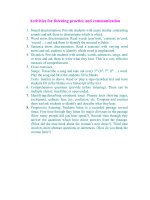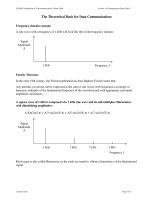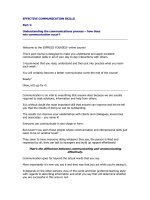Nonverbal communication Interculture
Bạn đang xem bản rút gọn của tài liệu. Xem và tải ngay bản đầy đủ của tài liệu tại đây (76.62 KB, 7 trang )
NONVERBAL COMMUNICATION
Communication studies traditionally have emphasized verbal and written
language, but in the late dozens of years have begun to consider
communication that takes place without words. In some types of
communication people express more nonverbally than verbally. It has been said
that communication is only 20 percent verbal while the rest is intonation, body
language. The fact remains that mastering vocabulary and grammar is only the
beginning of effective communication (John Mole, 2003). Speaking is just one
mode of communication. Research suggests that nonverbal communication is
more important in understanding human behavior than words and the
nonverbal “channels” seem to be more powerful than what people say.
Moreover, nonverbal communication varies from country to country, from
culture to culture. Cross-cultural Communication requires not only knowledge
of another language but also familiarity with nonverbal behavior and cultural
practices, values, and customs. Extending beyond an understanding of the
words, it is the ability to understand hidden meanings, motivations and
intentions.
Nonverbal communication is usually understood as the process of
communication through sending and receiving wordless messages. i.e.,
language is not the only source of communication, there are other means also.
Messages can be communicated through gestures and touch (Haptic
communication), by body language or posture, by facial expression and eye
contact. Meaning can also be communicated through object or artifacts (such as
clothing, hairstyles or architecture), symbols, and icons (or graphics). Speech
contains nonverbal elements known as paralanguage, including voice quality,
rate, pitch, volume, and speaking style, as well as prosodic features such as
rhythm, intonation and stress. Dance is also regarded as a form of nonverbal
communication. Likewise, written texts have nonverbal elements such as
handwriting style, spatial arrangement of words, or the physical layout of a
page.
Body language is the main part of this kind of communication. It concludes
gestures, body movements, facial expressions, and eye contact. Researchers
found wide variations even with such universal rituals as nodding agreement
and greeting friends. Although most cultures do indicate “yes” by a nod of the
head and “no” by shaking it, there are variations; In Ceylon, Greek,
Yugoslavia, Bulgaria, and Turkey, for example, a yes answer to a specific
question is indicated by a nod of the head, whereas general agreement is
indicated by a slow sideways swaying of the head. For greetings, in the United
States a handshake is appropriate. In France, where the traditional U.S.
handshake is considered too rough and rude, a quick handshake with only
slight pressure is preferred. In Latin America, a hearty embrace is common
among men and women alike, and men may follow it with a friendly slap on
the back. In Ecuador, to greet a person without a handshake is a sign of special
respect. In India, the handshake may be used by Westernized citizens, but the
preferred greeting is the amaste-placing the palms together and nodding one’s
head. In Japan, the traditional form of greeting is a bow or several bows.
Likewise, waving good-bye varies among cultures. In Italy, Colombia, and
China, people may wave good-bye by moving the palm and fingers back and
forth, a gesture that more likely means “come here” in the United States. But in
Malaysia, beckoning someone by moving the forefingers back and forth would
be taken as an insult. Even seemingly obvious gestures can be misunderstood.
Using fingers to indicate numbers can vary. In the United States, most people
would indicate “1” by holding up the forefinger. In parts of Europe, “1” is
indicated by using the thumb, “2” by the thumb and forefinger. The Japanese
point their forefingers to their faces to indicate they are referring to themselves,
Chinese point to their nose to signify “me”, whereas in the United States,
citizens are more likely to point to their chests. In France and Belgium, the
thumb-and-forefinger-in-a-circle (the okay gesture) has an insulting meaning:
“You are worth zero”, while in North America or some other parts of the
world, it is a friendly gesture. Eye contact is also very meaningful, but it, too,
can mean different things in different countries. One study showed that
Arabs, Latin Americans, and Southern Europeans focused their gaze on the
eyes or face of their conversational partner, whereas Asians, Indians and
Pakistanis, and Northern Europeans tend to show peripheral gaze or no gaze at
all ( Harper, Wiens & Matatazzo, 1978 ). Duration of eye contact varies in
diverse cultures (Shuter, 1979). In the United States, the average length of eye
contact is 2. 95 seconds, and the average length of time two people gaze at each
other is 1.18 seconds (Argyle, 1998; Argyle & Ingham, 1972). Any less than
that may be thought that the person is shy, uninterested or
preoccupied. Any more than that may indicate that the person is
communicating unusually high interest. American parents and teachers tell
children, “Look at me when I’m talking to you!” They feel sure that the other
person is listening if they can see his or her eyes. They think that it is important
to make eye contact during a conversation. To them, it’s a sign of openness and
honesty. It shows respect. They think that a person who doesn’t look at the eyes
of the listener may be hiding the truth. However, in some other cultures,
children are taught not to look directly at someone. For example, in some
Spanish-speaking countries, children show respect to an older person by not
looking directly into the person’s eyes during a conversation.
In different cultures, people also show their different attitudes to body space
and body touch in communication. They may keep a distance between
themselves and the person they are speaking to. It is called a “social distance.
In the U.S., people generally stand “at arm’s length” (about 30 inches) away
from a person they are talking to. Only family members, small children, and
sweethearts come closer. On the other hand, people from Japan, China, and
some northern European countries stand farther away (36 inches). To those
people, Americans seem to “get too close”. And to Americans, those other
people seem “cold” and distant. For two unacquainted North American adult
males, for example the comfortable distance to stand for conversation is about
two feet apart. The South American likes to stand much closer, which creates
problems when a South American and a North American meet face to face. The
South American who moves in to what is to him a proper talking distance may
be considered “pushy” by the North American; and the North American may
seem standoffish to the South American when he backs off to create a gap of
the size that seems right to him. Once a conversation was watched between a
Latin and a North American that began at one end of a forty-foot hall and
eventually wound up at the other end, the pair progressing by an almost
continual series of small backward steps on the part of the North American and
an equal closing of the gap by the Latin American. Let us take a look at
Chinese people; they do many more touches than Americans. It is quite usual
for the Chinese to walk hand in hand between the same sexes. But in America,
friends with the same sex never keep such a close distance. Such kind of
behavior is considered homosexual in the west and is strongly disgusted. Many
Chinese like to fondle the babies and very small children to show their
friendliness or affection. However, such actions like touching, patting, hugging
or kissing, can be quite embarrassing and awkward for the western mothers,
these behaviors would be considered rude and offensive in their eyes and could
arouse a strong dislike.
Various cultures have their own customs of different distance that make
their people feel comfortable in personal conversation situations. Participants
should understand these to fewer the unnecessary misunderstanding in
communication. The way human beings space themselves may be determined
not only by their culture and the particular relationships involved, but by other
factors as well. Studies have shown that when two people expect to compete,
they will usually sit opposite one another; expecting to cooperate, they sit side
by side; while for ordinary conversation, they sit at right angles. When
negotiators from two corporations hold a meeting, the teams may
automatically line up facing one another across the conference table. However,
if the meeting is adjourned for lunch, the men are likely to sit in alternating
chairs at the restaurant tables, each negotiator sandwiched between two men
from the other corporation. At a crowded cocktail party, people necessarily
stand closer together to talk, and experiments indicate that they also stand
closer in a public place, such as a park or on the street. Psychological studies
have shown that people choose to stand closer to someone they like than to
someone they don’t; that friends stand closer than acquaintances do, and
acquaintances closer together than strangers. The evidence also indicates that,
in intimate situations, introverts maintain slightly greater distances than
extroverts, and that pairs of women stand closer to talk than do pairs of men.
People from different cultures have very different feelings about hugging and
touching. Some Americans may touch the arm of the person they are talking to
while they are speaking. A man may gently slap another man on the back when
greeting him. Many Americans hug their family members and good friends
when they greet them or say good-bye. However, some Americans do not enjoy
being hugged in public. There is a great variety of feelings about hugging
strangers. Some people will warmly hug a new person they are introduced to.
Others may take a long time before they give a friend a hug when they say
hello or good-bye. People from south if America or southern Europe frequently
touch the person they are speaking to. They touch on the arm, hand, or
shoulder. People from Japan seldom touch at all when speaking to others. A
hug, a touch, or standing close may mean nothing special to one person. It can
mean romance to a second person. And it can be offensive to a third person.
Americans say that hugs are good and four hugs a day is a requirement for
good health. Six is better, and eight is best. However, a hug from someone you
don’t wish to hug is not welcome.
Another conspicuous different of nonverbal communication among cultures
is paralanguage. The vocal cues that accompany spoken language are termed
paralanguage. Among the ingredients of paralanguage are pitch, speed, volume,
pause and silence. People use the basic elements to transfer the emotional and
intellectual meanings of their messages. Pitch is highness or lowness of the
voice, and it can serve as an emotional marker. The Chinese counterpart “好”
or “对” can be uttered in many ways to show different emotions, attitudes and
meanings. The way these little words are said is very important. Speed or
tempo can also carry strong emotions. And there is also difference between
Chinese speech and American speech. Chinese TV and radio speakers are far
slower than their American counterparts. The underlying causes of this marked
difference may be explained in two ways. One is that speech tempo tends to
increase with the development of industry. Industrialized countries have a
faster speech tempo than non-industrialized countries. The other is that the
English language has much more polysyllabic words and carries less
information per syllable than the Chinese language does. That is to say, the
same amount of information can be contained in fewer Chinese syllables.
Therefore, Chinese speech can afford to be slower than American speech.
Volume is another important component of paralanguage. The ways of
manipulating volume of speech vary across cultures. Americans and Chinese
use different speech volumes in adjusting their volume levels according to the
size of the audience and the physical environment. While making an address in
public, Americans may laugh heartily, they will often laugh loudly on a joyful
and relaxed celebration. However while giving a lecture, conversing or
telephoning, their volume of sound is much lower than Chinese’s. As a result,
when talking with a Chinese or hearing a Chinese telephoning, Americans are
not accustomed to the volume of sound of a Chinese. They are surprised to see
that Chinese talk loudly in places, ships, buses and other public places. But it
seems that many Chinese people lack this ability. A Chinese in America often
has some difficulties in adapting to the extra low voice that Americans are
accustomed to. He may not get used to the low voice in classroom
discussions, telephone conversations and office interviews. On the other hand,
an American who first comes to China may wonder why Chinese people like
quarrelling on the streets. Never do they realize that these people are actually
talking loudly. Different traditions view silence much differently. Chinese
people value silence more than the use of words, many of them believe that
inner peace and wisdom come only through silence, just as the old sayings
“Silence is gold”; “Silence speaks louder than sound”, etc. But in American
culture, Americans tend to think there is no communication in silence. For
instance, in response to the question “Will you marry me”, silence
in America would be interpreted as uncertainty; while in China it would be
interpreted as acceptance. We now look at a few cultural differences between
Chinese and Americans in the use of silence so that we might better understand
how a lack of words can influence the outcome of any communication event.
So if the complicating of all these nonverbal signals makes frustrated and then,
just keep silence, one are absolutely wrong when he/she does business with
people coming from America. Silence is treated as passive or negative
reaction, not a signal of agreement as in China. So when businessmen from
American culture show no reaction to a proposal or presentation, it should be
taken as a negative attitude.
Nonverbal behavior is often seen as distinct from speech, its primary
purpose being to communicate emotion and interpersonal relationships. But
there is another viewpoint. Nonverbal behavior and speech are closely
connected and separating the two seems artificial. In particular, hand and facial
gestures may be seen as visible acts of meaning just as words are audible acts
of meaning. Thus some researchers argue they should be seen as an integral
part of natural language. In this view, body language is not an alternative to
speech. The nonverbal and verbal are both parts of communication.
Nonverbal communication has sometimes been regarded as a kind of
language of emotion and interpersonal relation-ships. But nonverbal behavior is
also closely related to speech. Speakers move their bodies in time with speech.
This includes not only hand gestures but also all parts of the body. Spoken
languages have patterns. For example, spoken English is produced in groups of
words, typically averaging five in length. In each group there is one primary
vocal stress, conveyed principally through changes in pitch but also through
volume or rhythm. In one study, it was found that 90% of these primary
stresses were accompanied by synchronized body movement. These
synchronized body movements may have a variety of meanings. Head
movements can signal a great deal more than yes or no. Vigorous headshakes
may accompany emphatic words such as a lot, great or really. A wide sweep of
the head may be used to indicate inclusiveness with words such as everyone or
everything. When someone starts to quote directly from someone else, a shift in
head orientation may precede or directly accompany the quotation. Such
nonverbal behavior can be seen as integral to the message. Indeed, the words
and gestures work together to create the meaning. Thus, body movement is
arguably as fundamental as speech for the representation of meaning. The use
of hand gesture has shown to develop together with speech in children and to
dissolve together with speech in aphasia (a disorder that causes loss of speech.)
Body movement may be seen not just as an alternative to speech but as part of
a multi-channel system of communication, giving the skilled speaker further
options through which to convey meaning.
Nonverbal communication is more suitable than words for some
communication tasks. It is often quicker and easier to point to an object than to
describe it. Because body movement is visual, it is also a silent means of
communication and may be used when it is difficult to use speech. For
example, gesture may be used by people, who are not actually talking, to
comment on what is being said without breaking the flow of the speaker. Body
movement can be used without the mutual obligation or ritual conduct that
seems to be required by conversation. It may sometimes be used as a substitute
for speech where actually to formulate the words might be regarded as too
explicit or indelicate. Not only is body movement a visual form of
communication, it can be highly visible. One study of a party showed how
people used hand gesture as an initial salutation to capture another's attention
before entering into conversation. Another study showed how patients used
flamboyant gestures to attract the doctor's attention away from his medical
notes. In this context, gesture has the additional advantage of indirectness as
well as visibility. A direct request for attention might be seen as a challenge to
the doctor's authority.
Research into nonverbal communication has considerable practical
significance. Social behavior is a skill and as such it can be taught and learned.
Communications skills training is used for employment interviewing,
psychiatric therapy, intercultural communication, and occupational training for
teachers, doctors, nurses and the police. There are now tests specifically
intended to make objective assessments of social perception and which can be
used to train people in greater nonverbal perceptiveness. Nonverbal
communication research can be considered part of a wider movement - one in
which communication becomes the object of study in its own right. Its fine
details are now no longer necessarily regarded as trivial, irrelevant or
unimportant, while terms like body language and communication skills have
also passed into everyday language.
Cultural diversity in nonverbal communication is a topic of great practical
importance, since cultural differences in this kind communication are a major
source of friction, misunderstanding, and annoyance between cultural and
national groups (Michael Argyle, 1996). Body language covers a large area
referring to any little movement of any part of the body. According to some
scholars in the field, the body language vocabulary totals over 700,000 items.
Information is sent on attitude toward person (facing or leaning towards
another), emotional status (tapping fingers, juggling coins), and desire to
control the environment (moving towards or away from a person). All people
use movement to communicate, culture teaches people how to use and interpret
these movements. The differences in culture are amazing, especially in the area
of body language. Many nonverbal expressions vary from culture to culture,
and what is acceptable in one culture may be completely unacceptable in
another, and it is just those variations that make nonverbal misinterpretation a
barrier. Without these unwritten subtle systems of managing the tremendous
diversity of encounters in everyday life, man would be nothing but a machine.









